INSTITUT SUPERIEUR D'ANTHROPOLOGIE
INSTITUTE OF ANTHROPOLOGY
ONLINE COURSES / COURS A DISTANCE
WINTER TERM : JANUARY 2014
REGISTER NOW
GRECE – 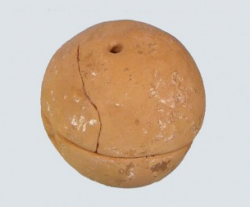
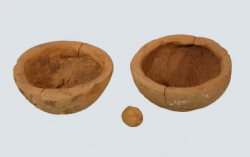 Ambracia- The 33rd Ephorate of Prehistoric and Classical Antiquities of Preveza and Arta and the Archaeological Museum of Arta present the exhibit of the month, a clay rattle. It was found in 1999 at the Western cemetery of Ambracia, during excavation works and it is dated in the late classical period (2nd half of the 4th century BC), outside a tomb. White coating is preserved on the surface of the rattle. It was decorated with color. On one side of the rattle, there is a hole in which a wooden handle was incerted. The rattle was a child’s first toy. By shaking it, it produced a sound that would make them stop crying. It was usually made of clay or metal. Many times the rattle was pig-shaped. The pig symbolized good fortune. They believed that this symbol brought the child good luck. Ancient Greeks believed that the sound produced by the rattle could keep the “evil spirits” away from the baby. The rattle was conserved in the laboratories of the museum. The rattle is exhibited in room B of the museum.
Ambracia- The 33rd Ephorate of Prehistoric and Classical Antiquities of Preveza and Arta and the Archaeological Museum of Arta present the exhibit of the month, a clay rattle. It was found in 1999 at the Western cemetery of Ambracia, during excavation works and it is dated in the late classical period (2nd half of the 4th century BC), outside a tomb. White coating is preserved on the surface of the rattle. It was decorated with color. On one side of the rattle, there is a hole in which a wooden handle was incerted. The rattle was a child’s first toy. By shaking it, it produced a sound that would make them stop crying. It was usually made of clay or metal. Many times the rattle was pig-shaped. The pig symbolized good fortune. They believed that this symbol brought the child good luck. Ancient Greeks believed that the sound produced by the rattle could keep the “evil spirits” away from the baby. The rattle was conserved in the laboratories of the museum. The rattle is exhibited in room B of the museum.
http://www.archaiologia.gr/en/blog/2014/01/08/a-clay-rattle-of-the-4th-century-bc/
CHINE – Xi'an - Archaeological research on a tomb built in the Tang Dynasty (AD618–907) revealed valuable information regarding the entombed remains, China News Service reported on Wednesday. The tomb was discovered by the Shaanxi Provincial Institute of Archaeology in August, 2013 at a construction site near Xi'an, capital of Shaanxi province. From the 982-word epitaph engraved on a slate unearthed from the tomb, archaeologists learned that the tomb was for Shangguan Wan'er, a well-known poet and politician in the Tang Dynasty. Shangguan Wan'er was killed in AD 710 when she was 47 years old during a palace coup she took part in.
http://www.ecns.cn/2014/01-08/96042.shtml
FRANCE – Montignac - La rumeur n'est pas nouvelle en vallée Vézère, mais l'info qui circule depuis quelques jours dans les médias repose sur un nouveau témoignage : un secret de famille vieux de 51 ans !En août dernier, une vieille dame a en effet révélé au maire qu'il existerait une autre grotte ornée à Montignac. La découverte a été faite par son mari et son beau-frère en 1962. A travers un orifice, ils ont aperçu un animal peint à la façon de Lascaux (selon les sources, il s'agirait d'un aurochs, ou d'un arrière-train animal). Mais ils ont préféré reboucher l'entrée et garder le secret, de crainte qu'on leur confisque le terrain. Aujourd'hui, les deux frères sont décédés, et la veuve du cadet a décidé de confier le secret au maire de Montignac. Si la dame n'a jamais vu la grotte, elle conserve dans son garage un tas de silex (mais qui ne dateraient pas du paléo sup) et une lampe à graisse qui serait de même modèle qu'à Lascaux (!). Des prospections sont prévues dans un secteur de 10 hectares environ. Cette cavité se situerait de l'autre côté de la rivière Vézère, à 4 km environ de Lascaux. Une zone que les gendarmes devront sécuriser, suite à cette médiatisation prématurée...
http://elebrun.canalblog.com/archives/2014/01/04/28849851.html
FRANCE – 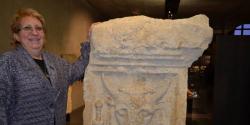
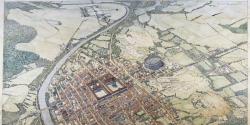 Périgueux -Sous l'actuelle ville de Périgueux se trouvent les vestiges de l'antique cité des Pétrucores. Chaque fois que l'on creuse, de nouvelles pièces du puzzle apparaissent. L'archéologue Claudine Girardy a suivi durant des années les fouilles pour le service régional d'archéologie et vient de publier (avec Hervé Gaillard et Etienne Saliège) "La carte archéologique de Périgueux". 166 sites y sont recensés sur lesquels des découvertes ont été faites depuis le XVIIIe siècle, notamment dans le rempart où des éléments étaient réemployés jusqu'à ces derniers mois par exemple sur le chantier de la nouvelle piscine. La plupart des trouvailles sont présentées au musée Vesunna de Périgueux qui est lui-même situé sur une domus découverte en 1959. En Aquitaine, Périgueux est l'une des villes les plus riches en vestiges antiques et il s'en découvre encore chaque année. La réalisation de maquettes pour le musée (la ville, le temple, la domus et l'amphithéâtre) a motivé de nombreuses recherches qui ont fait avancer la connaissance et permis leur restitution.
Périgueux -Sous l'actuelle ville de Périgueux se trouvent les vestiges de l'antique cité des Pétrucores. Chaque fois que l'on creuse, de nouvelles pièces du puzzle apparaissent. L'archéologue Claudine Girardy a suivi durant des années les fouilles pour le service régional d'archéologie et vient de publier (avec Hervé Gaillard et Etienne Saliège) "La carte archéologique de Périgueux". 166 sites y sont recensés sur lesquels des découvertes ont été faites depuis le XVIIIe siècle, notamment dans le rempart où des éléments étaient réemployés jusqu'à ces derniers mois par exemple sur le chantier de la nouvelle piscine. La plupart des trouvailles sont présentées au musée Vesunna de Périgueux qui est lui-même situé sur une domus découverte en 1959. En Aquitaine, Périgueux est l'une des villes les plus riches en vestiges antiques et il s'en découvre encore chaque année. La réalisation de maquettes pour le musée (la ville, le temple, la domus et l'amphithéâtre) a motivé de nombreuses recherches qui ont fait avancer la connaissance et permis leur restitution.
http://www.sudouest.fr/2014/01/02/archeologie-les-secrets-du-sous-sol-de-perigueux-1418175-1980.php
FRANCE – 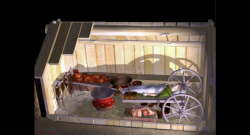 Warcq- La nouvelle avait été tenue secrète quelques jours au début de l’automne. Il se murmurait seulement que les chercheurs de la Cellule archéologique du conseil général, ainsi que les archéologues bénévoles qui les aident, étaient tombés sur « du lourd ». Le 8 octobre, nous révélions la nature de la trouvaille : une tombe à char en partie recouverte d’or, enterrée dans un champ depuis près de deux mille ans. Le site étant désormais surveillé jour et nuit par une société spécialisée, qui restera sur place jusqu’aux fouilles prévues en avril, nous pouvons préciser que la découverte a eu lieu à Warcq. Dès l’été des archéologues expérimentés avaient « senti » que le secteur pouvait réserver de belles surprises. Ce fut le cas mi-septembre, lorsque, les mains dans l’eau et les pieds dans la boue, fouillant une chambre funéraire d’environ 5,50 mètres sur 3,20, leurs doigts tombèrent sur des fragments métalliques circulaires et des éléments en bois très bien préservés. Enterrés sous 2,50 mètres d’argile, il s’agissait de morceaux de roues et de traces d’or. L’évidence s’est imposée d’elle-même : un aristocrate gaulois était (ou avait été) enterré ici, sur son char, au milieu d’objets précieux, selon la coutume funéraire chère à nos ancêtres. Une tradition assez bien connue en Champagne (y compris dans le Rethélois), mais jusqu’ici jamais vue dans le nord des Ardennes.Trois mois plus tard, la joie a cependant cédé la place à l’incertitude, voire la frustration. Alors que la tombe a été rebouchée et que la DREAL (Direction régionale de l’environnement, de l’aménagement et du logement, maître d’ouvrage de l’A 304) a passé un marché public spécial pour la fouiller durant quatre semaines, l’État a tenté de pousser vers la sortie les « petits » archéologues ardennais. Sur le mode, laissez faire les pros maintenant… Selon nos informations, l’INRAP (Institut national de recherches archéologiques préventives), dont les délais d’intervention très longs avaient, pour l’anecdote, justement conduit en 2009 à la création de la Cellule archéologique départementale, a tout fait pour s’accaparer le tombeau.
Warcq- La nouvelle avait été tenue secrète quelques jours au début de l’automne. Il se murmurait seulement que les chercheurs de la Cellule archéologique du conseil général, ainsi que les archéologues bénévoles qui les aident, étaient tombés sur « du lourd ». Le 8 octobre, nous révélions la nature de la trouvaille : une tombe à char en partie recouverte d’or, enterrée dans un champ depuis près de deux mille ans. Le site étant désormais surveillé jour et nuit par une société spécialisée, qui restera sur place jusqu’aux fouilles prévues en avril, nous pouvons préciser que la découverte a eu lieu à Warcq. Dès l’été des archéologues expérimentés avaient « senti » que le secteur pouvait réserver de belles surprises. Ce fut le cas mi-septembre, lorsque, les mains dans l’eau et les pieds dans la boue, fouillant une chambre funéraire d’environ 5,50 mètres sur 3,20, leurs doigts tombèrent sur des fragments métalliques circulaires et des éléments en bois très bien préservés. Enterrés sous 2,50 mètres d’argile, il s’agissait de morceaux de roues et de traces d’or. L’évidence s’est imposée d’elle-même : un aristocrate gaulois était (ou avait été) enterré ici, sur son char, au milieu d’objets précieux, selon la coutume funéraire chère à nos ancêtres. Une tradition assez bien connue en Champagne (y compris dans le Rethélois), mais jusqu’ici jamais vue dans le nord des Ardennes.Trois mois plus tard, la joie a cependant cédé la place à l’incertitude, voire la frustration. Alors que la tombe a été rebouchée et que la DREAL (Direction régionale de l’environnement, de l’aménagement et du logement, maître d’ouvrage de l’A 304) a passé un marché public spécial pour la fouiller durant quatre semaines, l’État a tenté de pousser vers la sortie les « petits » archéologues ardennais. Sur le mode, laissez faire les pros maintenant… Selon nos informations, l’INRAP (Institut national de recherches archéologiques préventives), dont les délais d’intervention très longs avaient, pour l’anecdote, justement conduit en 2009 à la création de la Cellule archéologique départementale, a tout fait pour s’accaparer le tombeau.
http://www.lunion.presse.fr/region/l-etat-tente-de-confisquer-le-tresor-archeologique-des-ia0b0n277319
BULGARIE –  Sveshtari - Archaeologists have uncovered the remains of a woman that appears to have been buried while pregnant, 6.000 years ago.The lady had been buried wearing exquisite pearl ornaments and according to the excavators, her pregnant state has been indicated by her burial position, with no further comments on the matter. The find was made in a newly discovered necropolis in Sveshtari in north-east Bulgaria. According to the BGNES news agency, five skeletons were discovered in the necropolis, all buried in an unusual position – with their legs bound and their heads facing southwards. Located in north-eastern Bulgaria, Razgrad region, the Sveshtari site, also known as Sboryanovo, hosts a great many remains of the Getae, a Thracian tribe whose major city of Helis is also thought to have been located nearby. Led by archeologist Diana Gergova, the locat archaeological team who uncovered the burial has been famous for revealing a 2500-year-old Thracian carriage and two horses in the same site last September. A unique gold Thracian treasure was discovered in Sveshtari in 2012.
Sveshtari - Archaeologists have uncovered the remains of a woman that appears to have been buried while pregnant, 6.000 years ago.The lady had been buried wearing exquisite pearl ornaments and according to the excavators, her pregnant state has been indicated by her burial position, with no further comments on the matter. The find was made in a newly discovered necropolis in Sveshtari in north-east Bulgaria. According to the BGNES news agency, five skeletons were discovered in the necropolis, all buried in an unusual position – with their legs bound and their heads facing southwards. Located in north-eastern Bulgaria, Razgrad region, the Sveshtari site, also known as Sboryanovo, hosts a great many remains of the Getae, a Thracian tribe whose major city of Helis is also thought to have been located nearby. Led by archeologist Diana Gergova, the locat archaeological team who uncovered the burial has been famous for revealing a 2500-year-old Thracian carriage and two horses in the same site last September. A unique gold Thracian treasure was discovered in Sveshtari in 2012.
http://www.archaiologia.gr/en/blog/2014/01/07/pregnant-for-6000-years/
INDE – 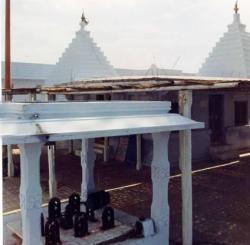 Koti Lingala - With the stage set for inaugural of Yellampalli project, people are raising their voice against the submergence of Koti Lingala village. The ancient and historic Sri Koteshwara and Siddeshwara Swamy Devasthanam located on the shores of the Godavari in Koti Lingala village of Velgatoor mandal, which would be submerged in the back waters of the Sripada Yellampalli project, is back in the news over its protection from submergence. The State Archaeology Department identified Koti Lingala as the protected site as the village was considered to be the first capital of Satavahana dynasty. The dynasty also used the river shores in the village for transportation of goods as was evident from the wharf constructed with the bricks on the shores. During the excavations by the Archaeology Department, the authorities recovered rare thrimukha coin (with pictures of Rama, Sita and Laxman) at the site. Even numismatists and historians crusaded for the protection of ancient site. With the completion of the project and government contemplating to inaugurate the project very soon, historians and others have again raised the issue of protection of the ancient village from submergence.
Koti Lingala - With the stage set for inaugural of Yellampalli project, people are raising their voice against the submergence of Koti Lingala village. The ancient and historic Sri Koteshwara and Siddeshwara Swamy Devasthanam located on the shores of the Godavari in Koti Lingala village of Velgatoor mandal, which would be submerged in the back waters of the Sripada Yellampalli project, is back in the news over its protection from submergence. The State Archaeology Department identified Koti Lingala as the protected site as the village was considered to be the first capital of Satavahana dynasty. The dynasty also used the river shores in the village for transportation of goods as was evident from the wharf constructed with the bricks on the shores. During the excavations by the Archaeology Department, the authorities recovered rare thrimukha coin (with pictures of Rama, Sita and Laxman) at the site. Even numismatists and historians crusaded for the protection of ancient site. With the completion of the project and government contemplating to inaugurate the project very soon, historians and others have again raised the issue of protection of the ancient village from submergence.
http://www.thehindu.com/news/national/andhra-pradesh/time-running-out-for-capital-of-satavahanas/article5548660.ece
USA – 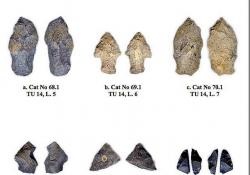 Bentleyville - The discovery of buried Indian artifacts where the state Department of Transportation is proposing to redesign back-to-back Interstate 70 interchanges at Bentleyville will not interfere with the nearly $50 million projects.The artifacts, including late Archaic Period tools and implements, were discovered after PennDOT changed its mind about the total elimination of the I-70 interchange at Route 917 after many local residents complained about the proposal when it was introduced at a public meeting in December 2012. That cloverleaf also is known as the Ginger Hill interchange.
Bentleyville - The discovery of buried Indian artifacts where the state Department of Transportation is proposing to redesign back-to-back Interstate 70 interchanges at Bentleyville will not interfere with the nearly $50 million projects.The artifacts, including late Archaic Period tools and implements, were discovered after PennDOT changed its mind about the total elimination of the I-70 interchange at Route 917 after many local residents complained about the proposal when it was introduced at a public meeting in December 2012. That cloverleaf also is known as the Ginger Hill interchange.
http://www.observer-reporter.com/article/20140106/NEWS01/140109594#.UsxVlvTuLVQ